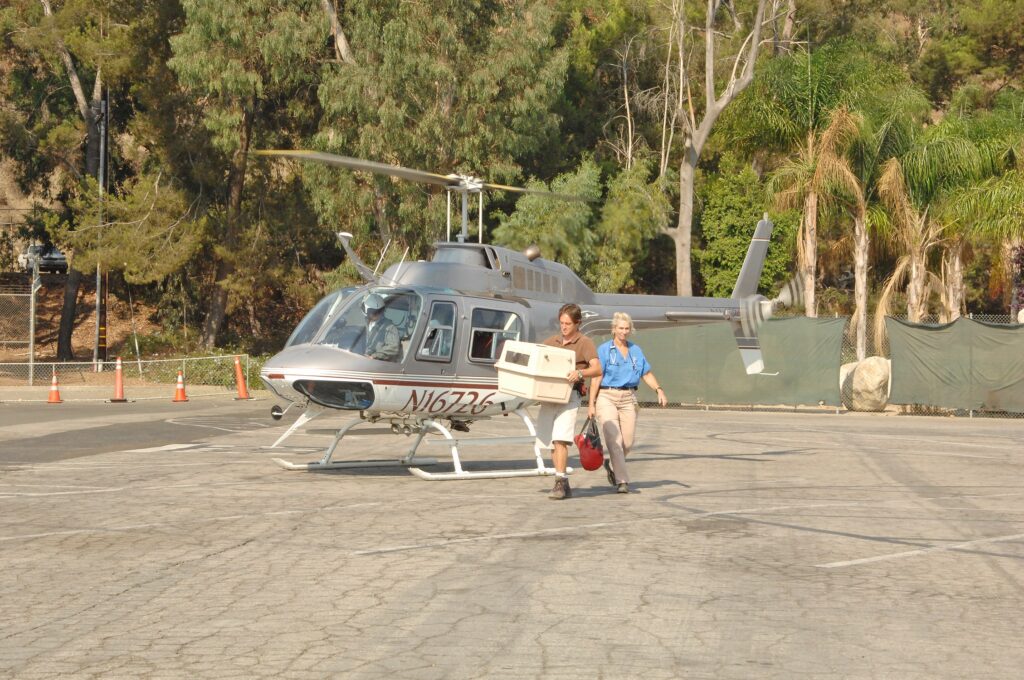by Autumn Hilden

“It’s a really emotional topic, because it’s two-sided. You worry about the birds,” says longtime California condor keeper Chandra David, “but you also worry about yourself.” She and condor keeper Mike Clark have been the cornerstones of the Zoo’s California condor team since the ‘90s and ‘80s, respectively, and they’re both retiring in November. “I won’t know how to do it,” she says. “It won’t be celebratory. It’ll be a very quiet day.”
Birds of a Feather
Like many of the stories the two tell about their career-long dedication to California condors, the one about their meeting is a long one. “She’ll be more succinct. So stick to that,” Mike says.
“Mike and I were in the same keeper class before we both started here in 1988,” Chandra remembers.
“Yeah, we didn’t know each other. I remember seeing her.”
“I remember hearing him ask questions to [former L.A. Zoo Curator of Birds] Mike Wallace and thinking, ‘This is so out of my league. These people are such bird nerds.’ In a good way,” she clarifies, “but it wasn’t my thing, coming from a primate background. I thought I was going to be the next Jane Goodall, but Wallace was just so inspiring, and he put a lot of trust in me and gave me a lot to work with. He was making it so cool.” Cooler than the two-year commitment she’d decided on in her mind.
“At one point I tried to leave [the birds], but I just was not happy. This program just constantly haunts you, in a good way. You just want to keep involved. You’re never done learning here. That’s what’s so amazing about it. Every day you come into work, there’s something else.”

It was different for Mike. “My whole life that’s all I thought about,” he says immediately when asked how he got involved with California condors. “Where I grew up, the people across the street from me had pigeons, turkeys, ducks, and chickens. I was really into incubating eggs, and I told the lady, Mrs. Taylor, ‘If I get an incubator, will you give me some chicken eggs?’ She said yes, and I lied to her [about having an incubator], because I wanted the eggs so bad. My friend Mikey and I took the eggs and kept them in our shirt tuck. Luckily, the chickens were about to hatch anyway. But we thought we were geniuses! We hatched these chickens out! We carried them everywhere.”
Soon Mike started breeding pigeons, chickens, and pheasants, and it wasn’t long before he became interested in raptors. Then it was falconry. Still, after high school he chose a “sensible” job in insurance. “But all I ever wanted to do was work at the zoo.”
In 1989, Mike’s experience with incubation was a perfect fit for a bourgeoning condor program that had not yet incubated its own eggs. But first, breeding facilities needed to be built. “I was young, and I could chainsaw and dig and be the labor,” he explains, “and I also had falconry experience.” Wallace, a fellow falconer, recognized the rare type of person who is attracted to falconry and who speaks the same kind of “bird language,” Mike says. But there was a hiring freeze in the City that prevented the Zoo from filling full-time positions, so Mike spent five years working two part-time jobs. Eventually, when the hiring freeze was lifted, the L.A. Zoo offered both Mike and Chandra full-time positions on the same day.

Learning to Fly
Soon it was time for the keepers to spread their wings, so to speak, and the two began to reexamine everything they knew about the program. “‘Why do we do it that way?’” explains Mike of the questions they asked themselves. “’And how can we do it better?’ Because there’s so much opportunity for growth.”
Questioning established methods, though, was not without challenges. “We were trying to figure out how to improve things without [going too far],” Mike says. They started looking at incubator and weight loss parameters, using logic and natural history to determine hand-feeding protocols. “We were not willing to risk the birds at all, we were just going to try to make it better.”
And it worked. “All your decisions from day one should be making sure this bird is going to fit into condor society just right when it’s released.” The feedback from the biologists who were managing the wild populations suggested their birds were easier and easier to handle the more they refined their techniques. “So people started looking to us more and more, people kept coming to us,” Chandra remembers. Their former mentor was one of those who came knocking.
Former L.A. Zoo Curator of Birds Dr. Mike Wallace had left to run the condor release program in Mexico from San Diego. “He was head of the California Condor Recovery Program, and he basically picked out every release site. The patagial tags on the wings?” Mike marvels, referring to the iconic identification system used to track birds released into the wild. “That was his idea.”

The birds released in Mexico came from varying facilities, and some that were released where no other condors had been, had behavioral problems. Wallace sent them to the L.A. Zoo for rehab. The condor team had “just completely revamped the hand-rearing protocol for California condors,” Mike remembers. They found a way to produce candidates for release that were as ready as parent-reared birds, the method for which was subsequently published in Cooper Ornithological Journal. The change was a huge success.
“No behavior problems, for the first time in an empty environment,” he says of the group reared with the new technique. He calls that group of a birds a “dream to manage,” noting that California condors are “heavily managed” in the wild. You need to “track them, pull blood, check their health, check their weight, manage their nests, feed them.” All things that—if working with wild birds—should be difficult to do.
They’ve continued to pioneer techniques since then. “We’ve done 20 double broods since 2017,” Mike shares proudly of the method that encourages adults to rear two eggs instead of the usual single egg. It was a method “we developed here that nobody would dare try, including us, for a long time. Every one we’ve done has been 100% successful.” So successful that this year they were encouraged to try triple brooding—and that worked too. This past year they also re-paired some longtime breeding duos using a new method of sparking interest between the males and females leading up to the breeding season.

